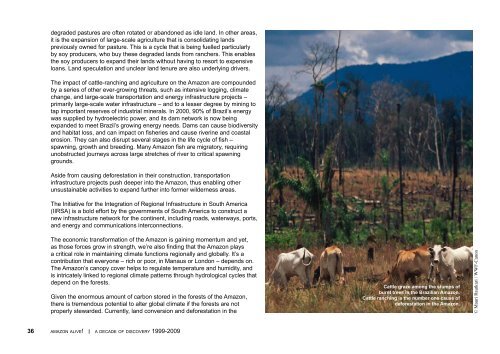Amazon Alive: A Decade of Discoveries 1999-2009 - WWF
Amazon Alive: A Decade of Discoveries 1999-2009 - WWF
Amazon Alive: A Decade of Discoveries 1999-2009 - WWF
You also want an ePaper? Increase the reach of your titles
YUMPU automatically turns print PDFs into web optimized ePapers that Google loves.
degraded pastures are <strong>of</strong>ten rotated or abandoned as idle land. In other areas,<br />
it is the expansion <strong>of</strong> large-scale agriculture that is consolidating lands<br />
previously owned for pasture. This is a cycle that is being fuelled particularly<br />
by soy producers, who buy these degraded lands from ranchers. This enables<br />
the soy producers to expand their lands without having to resort to expensive<br />
loans. Land speculation and unclear land tenure are also underlying drivers.<br />
The impact <strong>of</strong> cattle-ranching and agriculture on the <strong>Amazon</strong> are compounded<br />
by a series <strong>of</strong> other ever-growing threats, such as intensive logging, climate<br />
change, and large-scale transportation and energy infrastructure projects –<br />
primarily large-scale water infrastructure – and to a lesser degree by mining to<br />
tap important reserves <strong>of</strong> industrial minerals. In 2000, 90% <strong>of</strong> Brazil’s energy<br />
was supplied by hydroelectric power, and its dam network is now being<br />
expanded to meet Brazil’s growing energy needs. Dams can cause biodiversity<br />
and habitat loss, and can impact on fisheries and cause riverine and coastal<br />
erosion. They can also disrupt several stages in the life cycle <strong>of</strong> fish –<br />
spawning, growth and breeding. Many <strong>Amazon</strong> fish are migratory, requiring<br />
unobstructed journeys across large stretches <strong>of</strong> river to critical spawning<br />
grounds.<br />
Aside from causing deforestation in their construction, transportation<br />
infrastructure projects push deeper into the <strong>Amazon</strong>, thus enabling other<br />
unsustainable activities to expand further into former wilderness areas.<br />
The Initiative for the Integration <strong>of</strong> Regional Infrastructure in South America<br />
(IIRSA) is a bold effort by the governments <strong>of</strong> South America to construct a<br />
new infrastructure network for the continent, including roads, waterways, ports,<br />
and energy and communications interconnections.<br />
The economic transformation <strong>of</strong> the <strong>Amazon</strong> is gaining momentum and yet,<br />
as those forces grow in strength, we’re also finding that the <strong>Amazon</strong> plays<br />
a critical role in maintaining climate functions regionally and globally. It’s a<br />
contribution that everyone – rich or poor, in Manaus or London – depends on.<br />
The <strong>Amazon</strong>’s canopy cover helps to regulate temperature and humidity, and<br />
is intricately linked to regional climate patterns through hydrological cycles that<br />
depend on the forests.<br />
Given the enormous amount <strong>of</strong> carbon stored in the forests <strong>of</strong> the <strong>Amazon</strong>,<br />
there is tremendous potential to alter global climate if the forests are not<br />
properly stewarded. Currently, land conversion and deforestation in the<br />
Cattle graze among the stumps <strong>of</strong><br />
burnt trees in the Brazilian <strong>Amazon</strong>.<br />
Cattle ranching is the number one cause <strong>of</strong><br />
deforestation in the <strong>Amazon</strong>.<br />
© Mauri Rautkari / <strong>WWF</strong>-Canon<br />
36 amazon alive! I a decade <strong>of</strong> discovery <strong>1999</strong>-<strong>2009</strong>

















